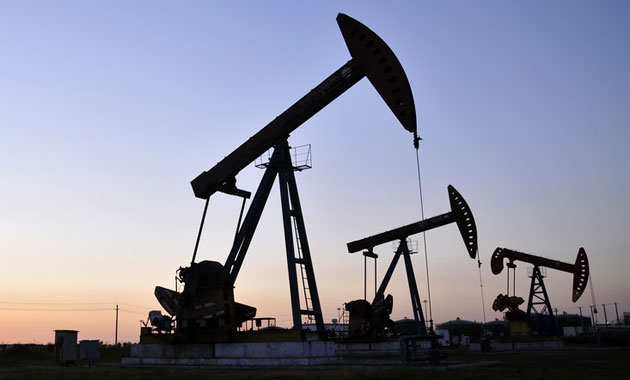By the end of next year, the United States is set to become the world's biggest oil producer. Once you grasp this, you understand that it has an incentive to promote higher oil prices, both to further its own oil industry and to generate big fat profits for the oil majors and bulging bonuses for oil company executives. The potential downside of driving the oil price higher, from the standpoint of those in control, is that designated enemies such as Iran and Russia might also benefit from these higher prices. So the way to prevent that from happening is to subject them to sanctions and oil export restrictions. The ordinary U.S. motorist facing stiff price hikes at the pumps can go fly a kite.
The predictions made in the last Oil Market update I wrote nearly three months ago, on 12th May (too long ago) turned out to be correct. We were looking for a near-term reaction and then an advance to new highs, and that is what happened, although it then proceeded to react back again during the first half of July and we will now proceed to consider the outlook.
On the latest 1-year chart for Light Crude we can see that the reaction back during the 1st half of July was nothing out of the ordinary, and it has brought the oil price back down to support near to the lower boundary of the intermediate uptrend shown, which is expected to turn the price back up again, especially as moving averages are still in quite strongly bullish alignment and the earlier overbought condition has fully unwound, as shown by the MACD indicator. However, on this chart we can also see a restrictive Dome pattern forming whose origins can be traced back to late last September, which may prevent the next rally getting as high as the upper return line of the uptrend channel before it turns down again, and we can get a better perspective on this Dome pattern by looking at the 3-year chart, which puts it in the context of the entire bullmarket advance to date from the early 2016 low, following the severe "crush Russia" bear market that preceded it and resulted in a lot of oil workers in the States being forced into idleness.
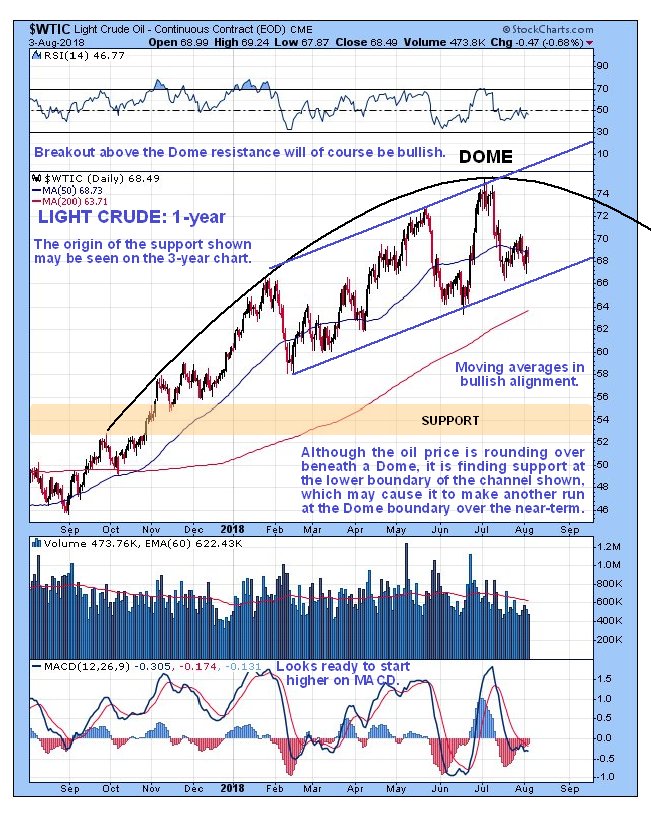
While the oil COT chart is not as useful as COT charts for other commodities, because it does make anywhere near such wild swings, it does reveal that Commercial short and Large Spec long positions are at relatively high levels historically. While they are not at levels that will necessarily prevent further gains, they put us on notice that should they climb to greater extremes a deeper reaction back will become more likely. A reaction back across the channel shown on the 3-year chart below would result in these readings easing to healthier levels.
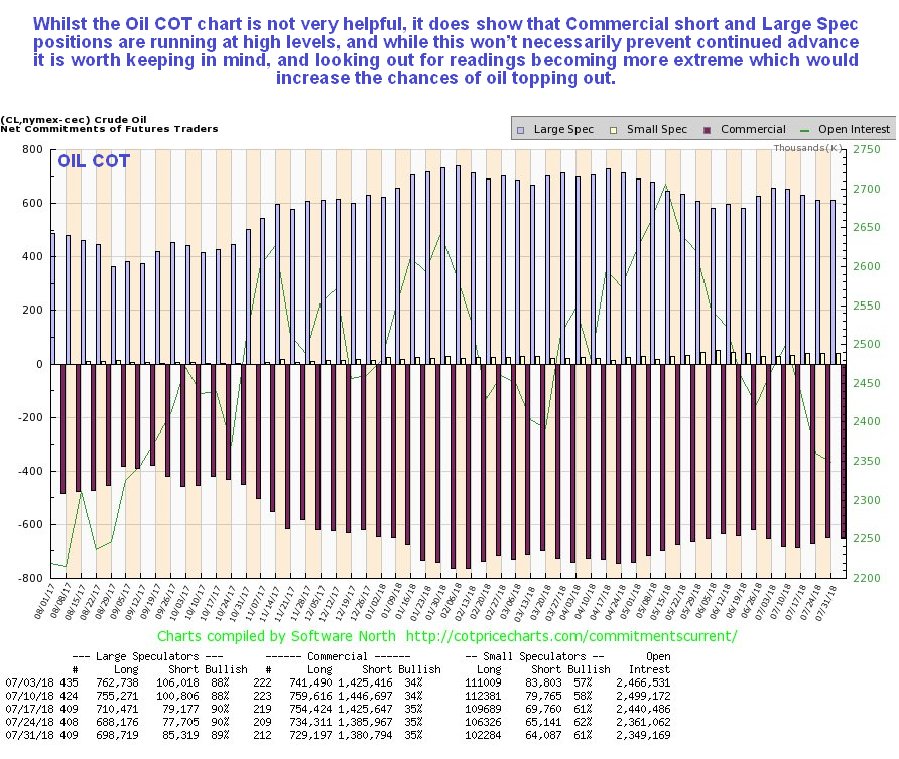
Click on chart to popup a larger, clearer version.
On the 3-year chart we can see clearly why oil's latest uptrend is running out of steam here. In the 1st place this intermediate uptrend has been in force for about a year now without any significant correction, which is quite a long time. Second, it now appears to be at the top or apex of the Dome that we already saw on the 1-year chart, which could force it lower soon, although as mentioned above it could first make a run at the Dome boundary. Third, we can see that a much larger potential channel exists, and it is viewed as no coincidence that the price is rounding over beneath a Dome pattern whose upper limits are roughly at the top of this channel. It could react back as far as the lower boundary of this large channel, currently at about $54.00, without damaging the long-term bullish picture. At this point a reaction this deep doesn't look likely, and it should be pointed out that oil's bull market could accelerate, since the origin of this channel is the low point of the giant base pattern, which means that it may be too shallow so that the oil price accelerates out the top of its requiring that a new steeper channel be drawn on the chart. Note also that these Dome patterns often only contain the price temporarily before it busts out the top into a new uptrend.
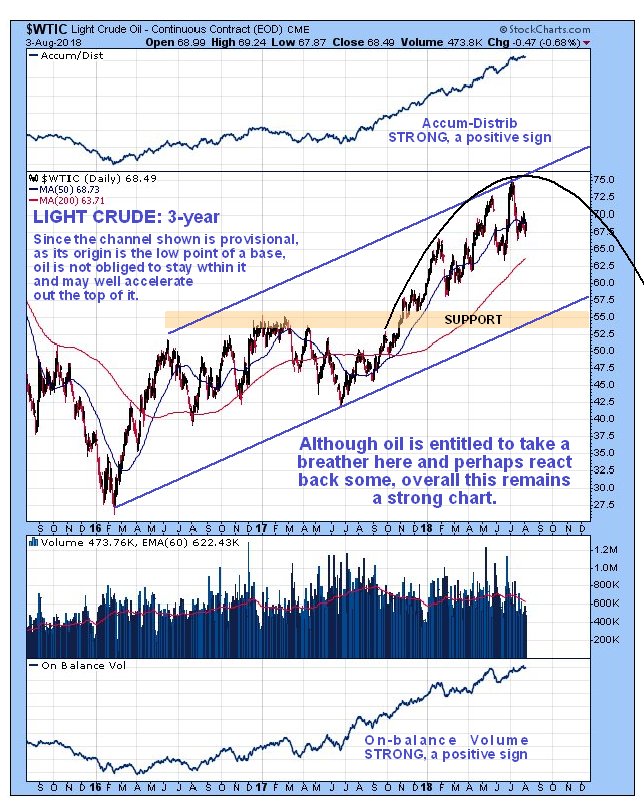
The very long-term 12-year chart gives us a most useful overall perspective. On this chart we can see the huge run-up in the oil price during 2007 and early 2008 that was followed by a more dramatic selloff occasioned by the 2008 market crash. The price then made back a good portion of the losses caused by the crash, peaking again in 2011, and then chopped sideways for years before plummeting in 2014 in the "crush Russia" crash, which was a concerted attempt by Saudi and the U.S. to force Russia to the wall, which didn't work. What it did do is cause the price to drop to even lower levels than at the trough of the 2008-2009 market crash, resulting in thousands of U.S. oil workers being thrown out of work. After this severe decline to a low level a downsloping Head-and-Shoulders bottom formed, which the price broke out of into a new bull market just last Fall. Going just on price alone this new bull market looks rather anemic and like it may peter out and reverse into another bear market before much longer, and while we can expect this to happen if we see another 2008 meltdown, the heavy volume driving this advance and the resulting strong volume indicators suggest that there is a lot of power behind this bull market, which could take the oil price a lot higher if the general market crash that threatens holds off for long enough. With respect to this, it is now worth looking in some detail at how the oil price was influenced by the 2007–2009 general market crash, which we can do by looking at a chart for this timeframe with the S&P500 index added to it.
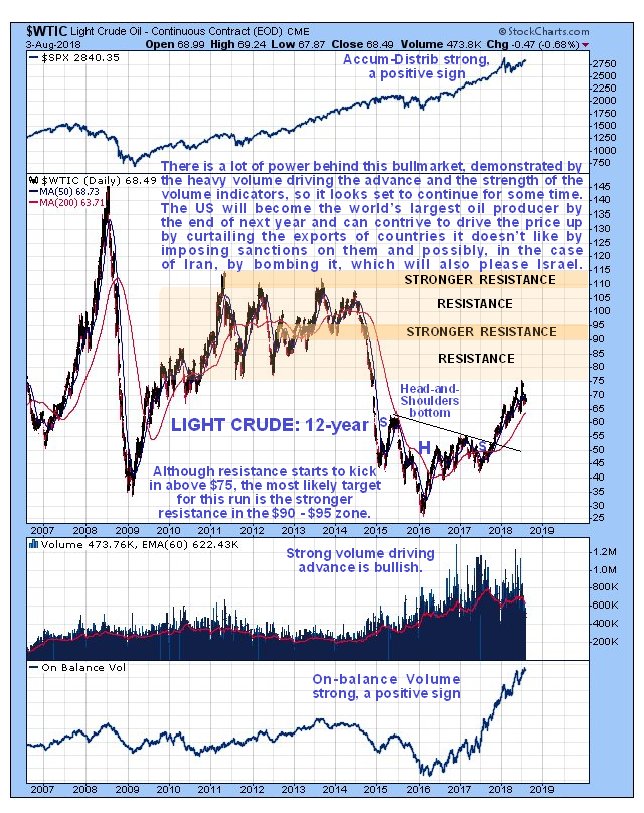
The chart for Light Crude for the 2007–2009 time frame is most interesting as it shows truly extraordinary price gyrations of huge magnitude for this, the most important commodity in the world. During 2007 and the 1st half of 2008 the price ascended in a parabolic arc, peaking at about $147 in July of 2008. What is most noteworthy about this with respect to what is going on today is that oil was not deterred from ramping higher by the fact that a bear market had already become established in the broad stock market, as shown by the S&P500 index shown at the top of this chart. The stock market was already 9 months into its bear market by the time it negatively impacted the oil price, but after the oil price broke down from its parabolic uptrend and then below its 200-day moving average, it crashed along with the stock market. The takeaway from this is that an emerging bear market in stocks won't necessarily stop oil in its tracks, at least until it has been underway for some time and is approaching the crash phase.
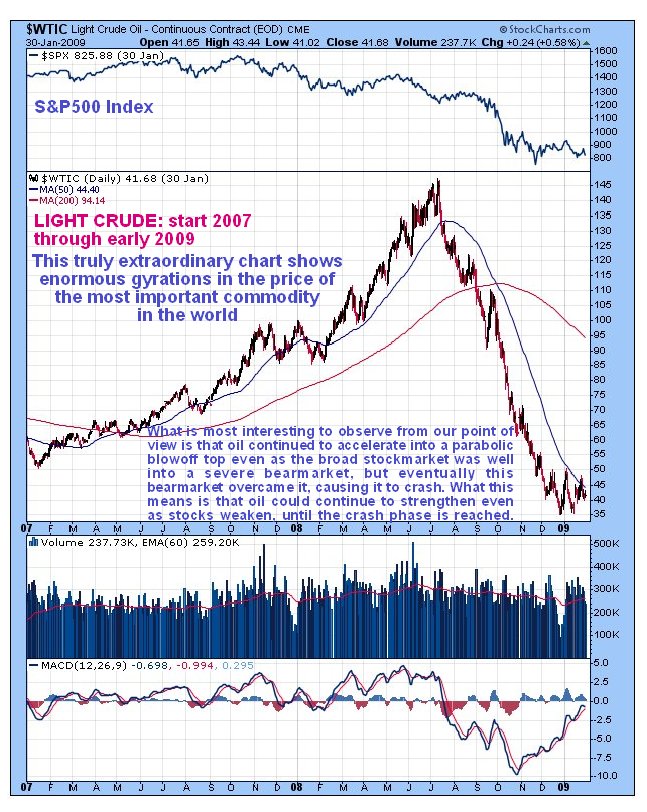
Finally, the Crude Oil Optix, or optimism chart, shows that optimism is at the sort of levels that frequently lead to a significant reaction, and the look of this chart suggests a higher chance that Light Crude will react back across the larger channel shown on our 3-year chart, probably after 1st rallying up towards the Dome boundary.
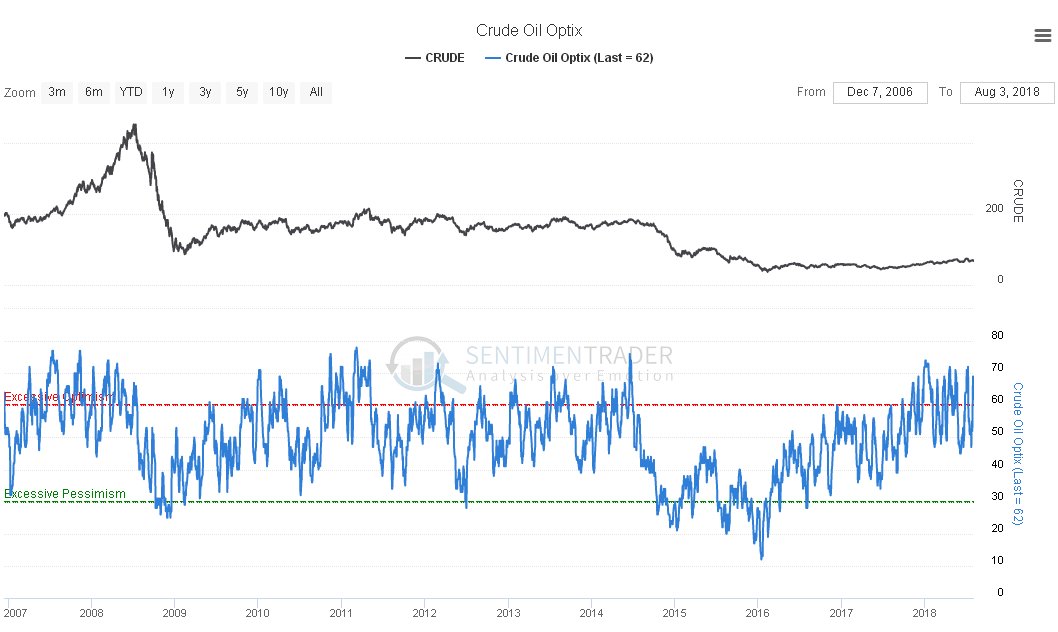
Click on chart to popup a larger, clearer version.
Chart courtesy of sentimentrader.com
Finally, seasonal factors for oil are at their second most positive of the year during August, which by itself makes a near-term rally more likely.
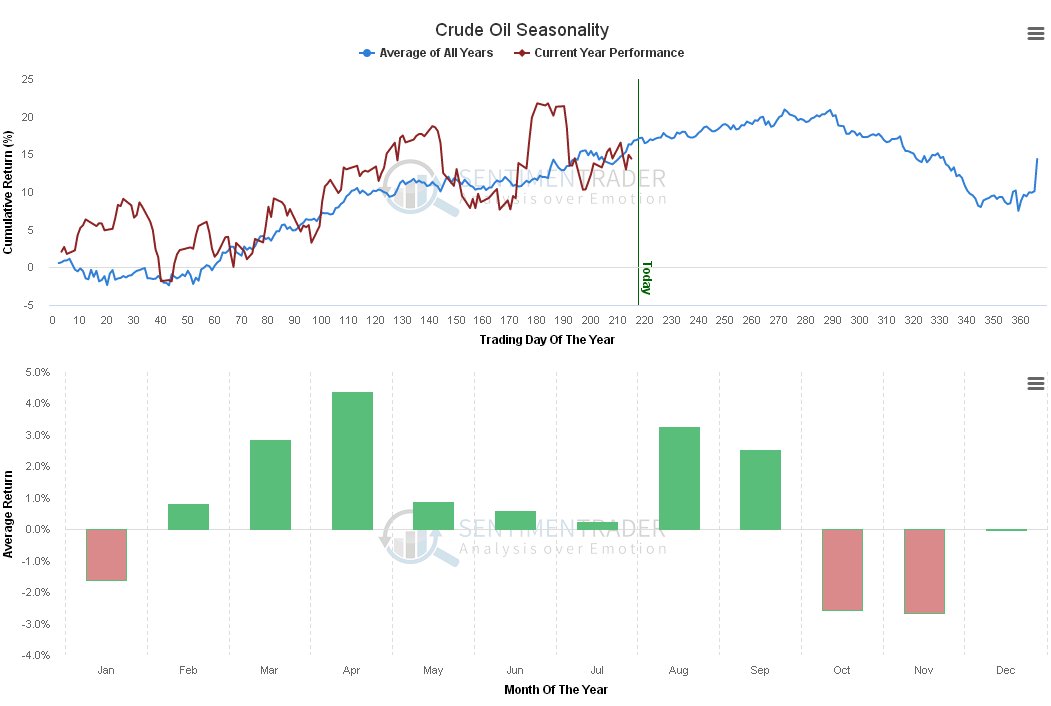
Click on chart to popup a larger, clearer version.
Chart courtesy of sentimentrader.com
Conclusion: While a near-term rally up to the $73-$74 area looks likely, there is a good chance that it will be followed by a deeper reaction back across the channel delineated on the 3-year chart, which might take the price back to, say, $58-$60. Thereafter the price should advance anew, provided a broad-based market crash doesn't hit, that might see oil reach the $90-$95 area or even higher.
Clive Maund has been president of www.clivemaund.com, a successful resource sector website, since its inception in 2003. He has 30 years' experience in technical analysis and has worked for banks, commodity brokers and stockbrokers in the City of London. He holds a Diploma in Technical Analysis from the UK Society of Technical Analysts.
[NLINSERT]Disclosure:
1) Statements and opinions expressed are the opinions of Clive Maund and not of Streetwise Reports or its officers. Clive Maund is wholly responsible for the validity of the statements. Streetwise Reports was not involved in the content preparation. Clive Maund was not paid by Streetwise Reports LLC for this article. Streetwise Reports was not paid by the author to publish or syndicate this article.
2) This article does not constitute investment advice. Each reader is encouraged to consult with his or her individual financial professional and any action a reader takes as a result of information presented here is his or her own responsibility. By opening this page, each reader accepts and agrees to Streetwise Reports' terms of use and full legal disclaimer. This article is not a solicitation for investment. Streetwise Reports does not render general or specific investment advice and the information on Streetwise Reports should not be considered a recommendation to buy or sell any security. Streetwise Reports does not endorse or recommend the business, products, services or securities of any company mentioned on Streetwise Reports.
3) From time to time, Streetwise Reports LLC and its directors, officers, employees or members of their families, as well as persons interviewed for articles and interviews on the site, may have a long or short position in securities mentioned. Directors, officers, employees or members of their immediate families are prohibited from making purchases and/or sales of those securities in the open market or otherwise from the time of the interview or the decision to write an article, until one week after the publication of the interview or article.
Charts provided by the author.
CliveMaund.com Disclosure:
The above represents the opinion and analysis of Mr Maund, based on data available to him, at the time of writing. Mr. Maund's opinions are his own, and are not a recommendation or an offer to buy or sell securities. Mr. Maund is an independent analyst who receives no compensation of any kind from any groups, individuals or corporations mentioned in his reports. As trading and investing in any financial markets may involve serious risk of loss, Mr. Maund recommends that you consult with a qualified investment advisor, one licensed by appropriate regulatory agencies in your legal jurisdiction and do your own due diligence and research when making any kind of a transaction with financial ramifications. Although a qualified and experienced stock market analyst, Clive Maund is not a Registered Securities Advisor. Therefore Mr. Maund's opinions on the market and stocks can only be construed as a solicitation to buy and sell securities when they are subject to the prior approval and endorsement of a Registered Securities Advisor operating in accordance with the appropriate regulations in your area of jurisdiction.


